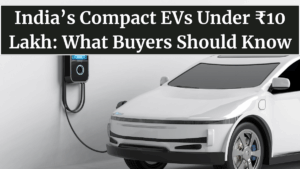The India compact EVs under ₹10 lakh segment is heating up faster than ever. Affordable electric cars are no longer just futuristic concepts — they are becoming mainstream choices for budget-conscious Indian buyers. With rising fuel prices and improved EV infrastructure, the demand for budget electric vehicles in India is witnessing record growth. Manufacturers are now competing to offer compact, feature-rich, and eco-friendly options that make switching to EVs easier for the masses.

The Growing Market for Budget Electric Vehicles
India’s EV market has traditionally been dominated by premium models like the Tata Nexon EV and MG ZS EV, priced well above ₹15 lakh. However, in 2025, the focus has shifted toward compact and affordable models under ₹10 lakh, designed specifically for urban users and first-time buyers.
Manufacturers like Tata Motors, MG Motor India, and Maruti Suzuki are leading the charge by developing small EVs that prioritize efficiency and affordability. The success of Tata Tiago EV and MG Comet EV has proven that there is strong appetite among Indian consumers for compact electric vehicles that balance cost and quality.
Why Compact EVs Are Booming in India
Several factors are driving the popularity of compact EVs in India:
-
Government incentives under FAME-II and state-level EV policies make these cars more affordable.
-
Reduced running costs compared to petrol or diesel vehicles — electricity per km is almost one-third the cost of fuel.
-
Improved charging infrastructure across metro and Tier-2 cities.
-
Rising fuel prices and environmental awareness among younger buyers.
Compact EVs also cater to India’s dense city roads where small, nimble vehicles are more practical. The ability to park easily, maneuver through traffic, and charge at home makes them an ideal urban commuting solution.
Popular Models Under ₹10 Lakh
Several models in India’s sub-₹10 lakh EV category are gaining momentum:
| Model | Approx. Price | Range (ARAI Certified) | Notable Features |
|---|---|---|---|
| Tata Tiago EV | ₹8.69 – ₹9.99 lakh | 250–315 km | Fast charging, connected tech |
| MG Comet EV | ₹7.98 – ₹9.98 lakh | 230 km | Smart infotainment, compact size |
| PMV EaS-E | ₹4.79 lakh | 200 km | Micro car with smart connectivity |
| Citroën eC3 (base variant) | Around ₹10 lakh | 320 km | Air-cooled battery, SUV styling |
These cars show how automakers are adapting to India’s affordability-focused market while still ensuring safety, connectivity, and design appeal.
Challenges in the Affordable EV Segment
Despite the growing interest, affordable EVs in India face challenges such as limited battery capacity, range anxiety, and charging access in smaller towns. Many buyers still hesitate due to concerns about battery replacement costs and resale value.
However, automakers are addressing these issues through battery warranties, subscription-based ownership models, and expanding charging networks in collaboration with energy providers and local governments.
Government Support & Infrastructure Growth
The Indian government’s initiatives — such as the FAME-II subsidy, GST reduction to 5%, and state EV incentives — have made EVs more accessible than ever. Cities like Delhi, Pune, Hyderabad, and Chennai are seeing a rapid increase in public and private charging stations.
Additionally, new partnerships between Tata Power, Ather Grid, and Jio-bp Pulse are bringing fast-charging networks to highways and residential societies, supporting long-term EV adoption.
The Road Ahead for Budget EVs
The next wave of compact EVs will be even more competitive. Companies like Maruti Suzuki, Hyundai, and Mahindra are planning sub-₹10 lakh models with better range, faster charging, and localized components to reduce costs. As battery technology becomes cheaper and more efficient, the ₹10 lakh mark may soon include even mid-segment cars.
The focus is now on making EVs not just affordable but aspirational, with designs, interiors, and tech that appeal to both young professionals and families. For India, compact EVs represent not just an evolution in transport — but a revolution in accessibility and sustainability.
FAQs
Which is the cheapest EV available in India in 2025?
The PMV EaS-E, priced around ₹4.79 lakh, is currently India’s most affordable electric car.
Are sub-₹10 lakh EVs suitable for long-distance travel?
They’re mainly designed for city use but can handle short intercity trips with careful planning and public charging access.
What incentives can reduce EV prices further?
Buyers can benefit from FAME-II subsidies, state-level rebates, and reduced GST, significantly lowering the on-road cost.
How much does it cost to charge a small EV fully?
A full charge typically costs between ₹100 and ₹150, depending on local electricity rates and battery size.
Are compact EVs safe?
Yes, most new EVs under ₹10 lakh comply with global safety norms and include airbags, ABS, and connected safety features.
Click here to know more.
